An Energy-Efficient Clustering Method for Target Tracking Based on Tracking Anchors in Wireless Sensor Networks
Abstract
1. Introduction
- Tracking anchors are introduced to indicate sensor activation based on the target position. Since there is no task of sending, receiving, and fusing data, the tracking anchor consumes little energy and therefore does not need to be reselected periodically.
- Using the rough-fuzzy C-means (RFCM) algorithm, we can determine the anchor location, and a membership table will be built according to the sensors’ membership to the lower approximate and boundary region of anchors. The membership table can help the system activate the appropriate sensor set.
- The activated sensor set temporarily forms a dynamic cluster, and the CH is selected employing delay broadcasting. The linear 0–1 programming is used to schedule the state of CMs to reduce the transmission of redundant data in the cluster.
2. Related Work
3. System Model
3.1. Network Model
- All the sensor nodes are static and do not change their location once deployed.
- Each node can be identified by its unique ID that differs from other nodes.
- All the sensors have knowledge of their location according to an equipped GPS.
- The collisions during transmission are not considered in the network, and the radio channels are symmetric.
- The sensing radius and communication radius of each node are and , respectively. Set to ensure that all nodes that sense the target can communicate with each other.
- The sensing model of the node adopts the Boolean omnidirectional model, which is given by [27]:where is the probability that sensor can sense the target, and is the distance from sensor to target. is the sensing radius.
3.2. Energy Model
4. The Proposed Tracking Anchor Based Clustering Method
4.1. Tracking Anchor Determination
| Algorithm 1. Tracking Anchor Determination Based on RFCM |
| Input: Node Number , Tracking Anchor Number Output: Tracking Anchor Locations, Node Membership 1: Parameter Initialization: , Fuzzifier , Thresholds and 2: Initialize Population 3: Repeat 4: For Each in do 5: Calculate for anchors and nodes using Equation (10) |
| 6: End for 7: If and be the two highest membership of and then 8: and 9: Else 10: 11: End if 12: Modify considering lower and boundary regions 13: Compute new anchors as Equation (11) 14: Until or 15: For each sensor in the network do 16: Assigned as a member to the anchors with maximum |
| 17: End for |
4.2. Node Activation
- (1)
- The target is located in the lower approximation region of a certain anchor. As shown in Figure 5, only the sensors in the lower approximate region will be activated because they have received a “Node Activation” message from the only anchor to which they belong.
- (2)
- The target is located in the overlapping boundary region of multiple anchors. As shown in Figure 6, the nodes in the lower approximation regions and the overlapping boundary region of the two anchors will be activated. The overlapping boundary region of the two anchors can be used as a transition region to ensure the continuity of the tracking process.
4.3. Cluster Formation
4.4. State Scheduling for CMs
| Algorithm 2 State Scheduling for CMs |
| Input: Cluster Member Number , node in the sensing or sensing-transmitting state Output: Optimal State of Cluster Members 1: Parameter Initialization: Consumed Energy , Minimum Number of Nodes to Transmit 2: Initial Solution: Randomly selecting CMs to be in the sensing-transmitting state, satisfying Equation (24), and calculate the objective function value as using Equation (23). 3: Add to the constraints, Equation (24) becomes Equation (25) 4: Enumerate solutions. 5: For each solution 6: If Equation (25) is satisfied then 7: Calculate the objective value by Equation (23) to be 8: If then 9: Set in the third constraint of Equation (25) 10: Else 11: The solution is eliminated. |
| 12: End for 13: The value of cannot be smaller, and the optimal solution can be obtained, which denotes the optimal status of CMs. |
5. Performance Evaluation
5.1. Simulation Setup
5.2. Performance Analysis
5.3. Threats to Validity
6. Conclusions
Author Contributions
Funding
Institutional Review Board Statement
Informed Consent Statement
Conflicts of Interest
References
- Xie, H.M.; Yan, Z.; Yao, Z.; Atiquzzaman, M. Data Collection for Security Measurement in Wireless Sensor Networks: A Survey. IEEE Internet Things 2019, 6, 2205–2224. [Google Scholar] [CrossRef]
- Yang, H.; Feng, Z.X.; Teng, X.L.; Guan, L.; Hu, H.; Wu, M.B. Three-dimensional printing of high-mass loading electrodes for energy storage applications. InfoMat 2020, 3, 631–647. [Google Scholar] [CrossRef]
- Jamshed, M.A.; Ali, K.; Abbasi, Q.H.; Imran, M.A.; Ur-Rehman, M. Challenges, Applications, and Future of Wireless Sensors in Internet of Things: A Review. IEEE Sens. J. 2022, 22, 5482–5494. [Google Scholar] [CrossRef]
- Han, B.; Ran, F.; Li, J.; Yan, L.M.; Shen, H.M.; Li, A. A Novel Adaptive Cluster Based Routing Protocol for Energy-Harvesting Wireless Sensor Networks. Sensors 2022, 22, 1564. [Google Scholar] [CrossRef]
- Rashid, B.; Rehmani, M.H. Applications of wireless sensor networks for urban areas: A survey. J. Netw. Comput. Appl. 2016, 60, 192–219. [Google Scholar] [CrossRef]
- Demigha, O.; Hidouci, W.K.; Ahmed, T. On Energy Efficiency in Collaborative Target Tracking in Wireless Sensor Network: A Review. IEEE Commun. Surv. Tutor. 2013, 15, 1210–1222. [Google Scholar] [CrossRef]
- Yick, J.; Mukherjee, B.; Ghosal, D. Wireless sensor network survey. Comput. Netw. 2008, 52, 2292–2330. [Google Scholar] [CrossRef]
- Souza, É.L.; Nakamura, E.F.; Pazzi, R.W. Target tracking for sensor networks: A survey. ACM Comput. Surv. 2016, 49, 1–31. [Google Scholar] [CrossRef]
- Bhatti, S.; Khanzada, T.J.S.; Memon, S. Clustering and Fault Tolerance for Target Tracking Using Wireless Sensor Networks. Mehran Univ. Res. J. Eng. Technol. 2012, 31, 769–776. [Google Scholar] [CrossRef]
- Chan, L.; Chavez, K.G.; Rudolph, H.; Hourani, A. Hierarchical routing protocols for wireless sensor network: A compressive survey. Wirel. Netw. 2020, 26, 3291–3314. [Google Scholar] [CrossRef]
- Wang, M.; Zeng, J. Hierarchical Clustering Nodes Collaborative Scheduling in Wireless Sensor Network. IEEE Sens. J. 2022, 22, 1786–1798. [Google Scholar] [CrossRef]
- Wang, Z.; Lou, W.; Wang, Z.; Ma, J.; Chen, H. A Hybrid Cluster-Based Target Tracking Protocol for Wireless Sensor Networks. Int. J. Distrib. Sens. Netw. 2013, 9, 494863. [Google Scholar] [CrossRef]
- Hu, Y.; Niu, Y.; Lam, J.; Shu, Z. An Energy-Efficient Adaptive Overlapping Clustering Method for Dynamic Continuous Monitoring in WSNs. IEEE Sens. J. 2017, 17, 834–847. [Google Scholar] [CrossRef]
- Qu, Z.; Xu, H.; Zhao, X.; Tang, H.; Wang, J.; Li, B. An Energy-Efficient Dynamic Clustering Protocol for Event Monitoring in Large-Scale WSN. IEEE Sens. J. 2021, 21, 23625. [Google Scholar] [CrossRef]
- Wang, Y.C.; Zhao, Q.C.; Zheng, D.Z.; Guan, X.H. On optimisation of cluster-based sensor network tracking system. Int. J. Ad Hoc Ubiquitous Comput. 2013, 14, 145–157. [Google Scholar] [CrossRef]
- Feng, J.; Zhao, H.W. Dynamic Nodes Collaboration for Target Tracking in Wireless Sensor Networks. IEEE Sens. J. 2021, 21, 21069–21079. [Google Scholar] [CrossRef]
- Ahmad, T.; Abbas, A.M. EEAC: An energy efficient adaptive cluster based target tracking in wireless sensor networks. J. Interdiscip. Math. 2020, 23, 379–392. [Google Scholar] [CrossRef]
- Arienzo, L.; Longo, M. Energy-efficient collaborative tracking in wireless sensor networks. Int. J. Sens. Netw. 2011, 9, 124–138. [Google Scholar] [CrossRef]
- Bhagat, D.P. Tracking of Moving Target in Wireless Sensor Network with Improved Network Life Time Using PSO. Wirel. Pers. Commun. 2021, 2021, 1–15. [Google Scholar] [CrossRef]
- Qu, Z.; Xu, H.; Zhao, X.; Tang, H.; Wang, J.; Li, B. A fault-tolerant sensor scheduling approach for target tracking in wireless sensor networks. Alex. Eng. J. 2022, 61, 13001–13010. [Google Scholar] [CrossRef]
- Cai, Z.X.; Wen, S.; Liu, L.J. Dynamic cluster member selection method for multi-target tracking in wireless sensor network. J. Cent. South Univ. 2014, 21, 636–645. [Google Scholar] [CrossRef]
- Fu, C.L.; Zhou, L.; Hu, Z.T.; Jin, Y.; Bai, K.; Wang, C. LEACH-MTC: A Network Energy Optimization Algorithm Constraint as Moving Target Prediction. Appl. Sci. 2021, 11, 9064. [Google Scholar] [CrossRef]
- Soderlund, A.A.; Kumar, M.; Donghoon, K. Rapid clustering for optimal sensor selection in heterogeneous wireless sensor networks. In Proceedings of the 2018 AIAA Guidance, Navigation, and Control Conference, Kissimmee, FL, USA, 8–12 January 2018; p. 1135. [Google Scholar]
- Liao, S.K.; Lai, K.J.; Tsai, H.P.; Wen, C.Y. Distributed Information Compression for Target Tracking in Cluster-Based Wireless Sensor Networks. Sensors 2016, 16, 937. [Google Scholar] [CrossRef]
- Afsar, M.M.; Tayarani-N, M.H. Clustering in sensor networks: A literature survey. J. Netw. Comput. Appl. 2014, 46, 198–226. [Google Scholar] [CrossRef]
- Yao, J.; Zhang, K.M.; Yang, Y.Y.; Wang, J. Emergency vehicle route oriented signal coordinated control model with two-level programming. Soft Comput. 2018, 22, 4283–4294. [Google Scholar] [CrossRef]
- More, A.; Raisinghani, V. A survey on energy efficient coverage protocols in wireless sensor networks. J. King Saud Univ.-Comput. Inf. Sci. 2017, 29, 428–448. [Google Scholar] [CrossRef]
- Wang, J.; Gao, Y.; Liu, W.; Sangaiah, A.K.; Kim, H.J. An Improved Routing Schema with Special Clustering Using PSO Algorithm for Heterogeneous Wireless Sensor Network. Sensors 2019, 19, 671. [Google Scholar] [CrossRef] [PubMed]
- Maji, P.; Pal, S.K. RFCM: A hybrid clustering algorithm using rough and fuzzy sets. Fundam. Inform. 2007, 80, 475–496. [Google Scholar]
- Tian, D.; Georganas, N.D. A coverage-preserving node scheduling scheme for large wireless sensor networks. In Proceedings of the 1st ACM International Workshop on Wireless Sensor Networks and Applications, Atlanta, GA, USA, 28 September 2002; pp. 32–41. [Google Scholar]
- Diaby, M. Implicit enumeration for the pure integer 0/1 minimax programming problem. Oper. Res. 1993, 41, 1172–1176. [Google Scholar] [CrossRef][Green Version]
- Du, X.; Wang, T.; Wang, L.; Pan, W.; Chai, C.; Xu, X.; Jiang, B.; Wang, J. CoreBug: Improving Effort-Aware Bug Prediction in Software Systems Using Generalized k-Core Decomposition in Class Dependency Networks. Axioms 2022, 11, 205. [Google Scholar] [CrossRef]
- Qu, Y.; Zheng, Q.; Chi, J.; Jin, Y.; He, A.; Cui, D.; Zhang, H.; Liu, T. Using K-core Decomposition on Class Dependency Networks to Improve Bug Prediction Model’s Practical Performance. IEEE Trans. Softw. Eng. 2021, 47, 348–366. [Google Scholar] [CrossRef]
- Khan, M.I.; Rinner, B.; IEEE. Energy-aware Task Scheduling in Wireless Sensor Networks based on Cooperative Reinforcement Learning. In Proceedings of the IEEE International Conference on Communications (ICC), Sydney, Australia, 10–14 June 2014; pp. 871–877. [Google Scholar]
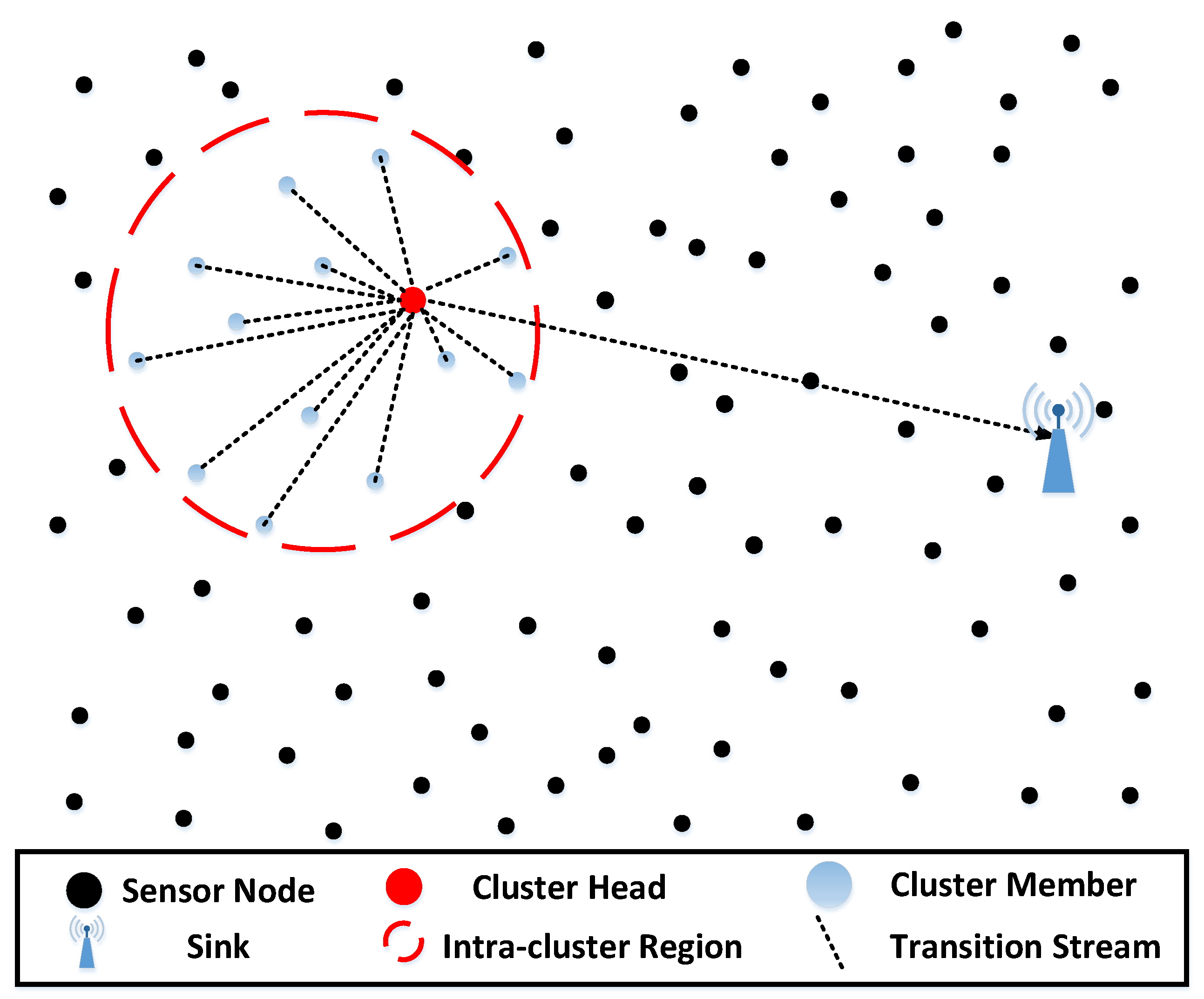
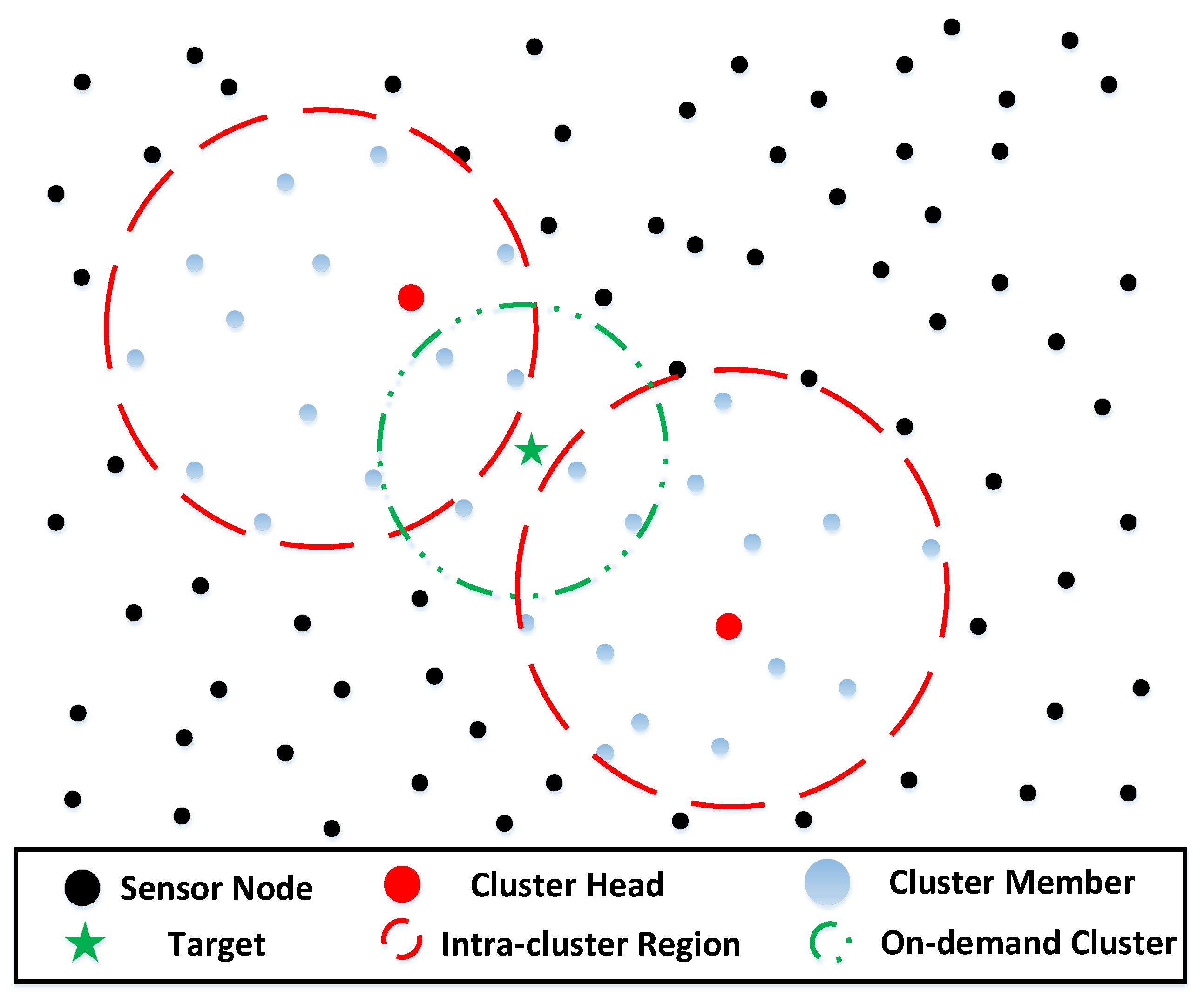
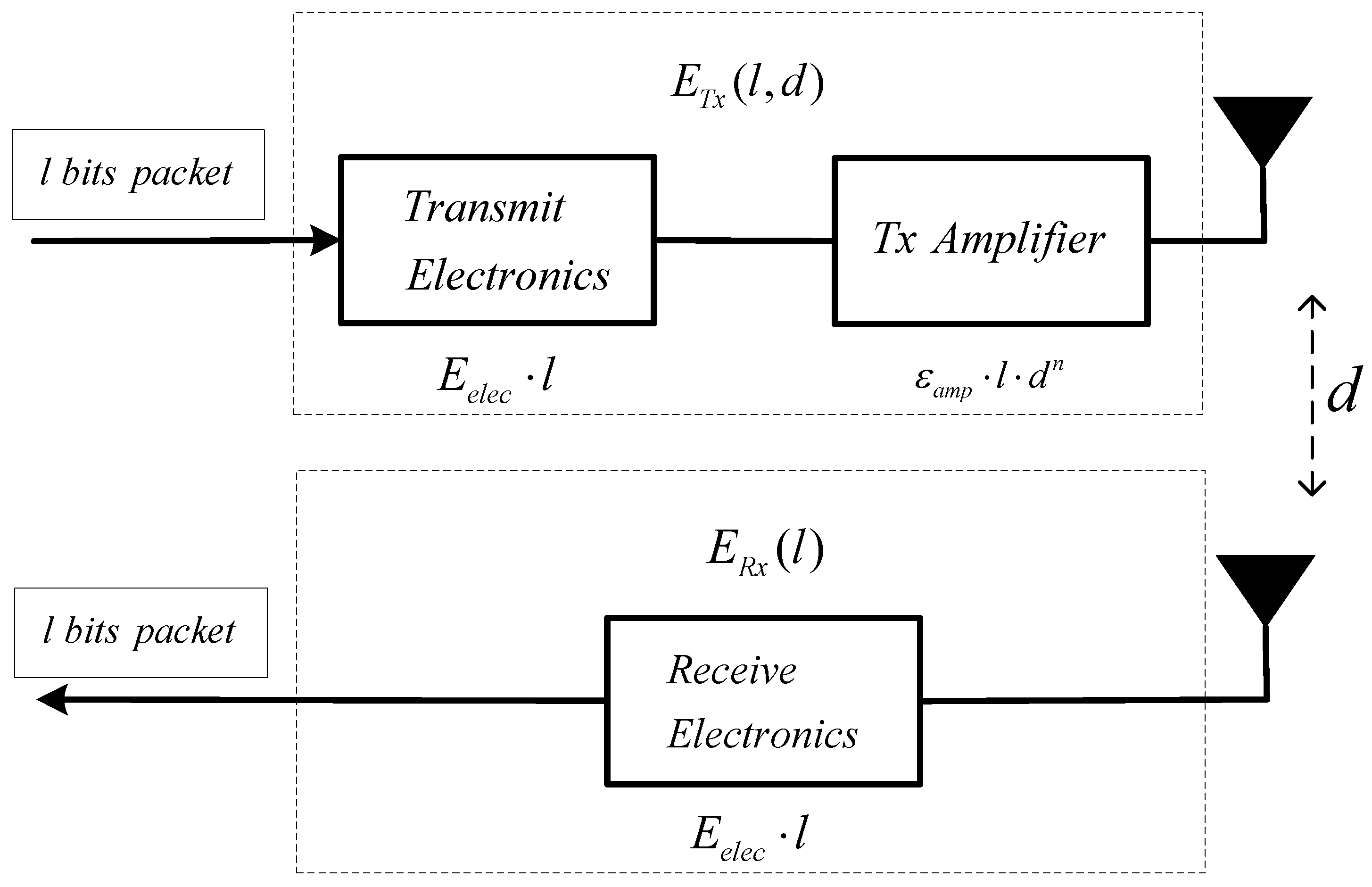

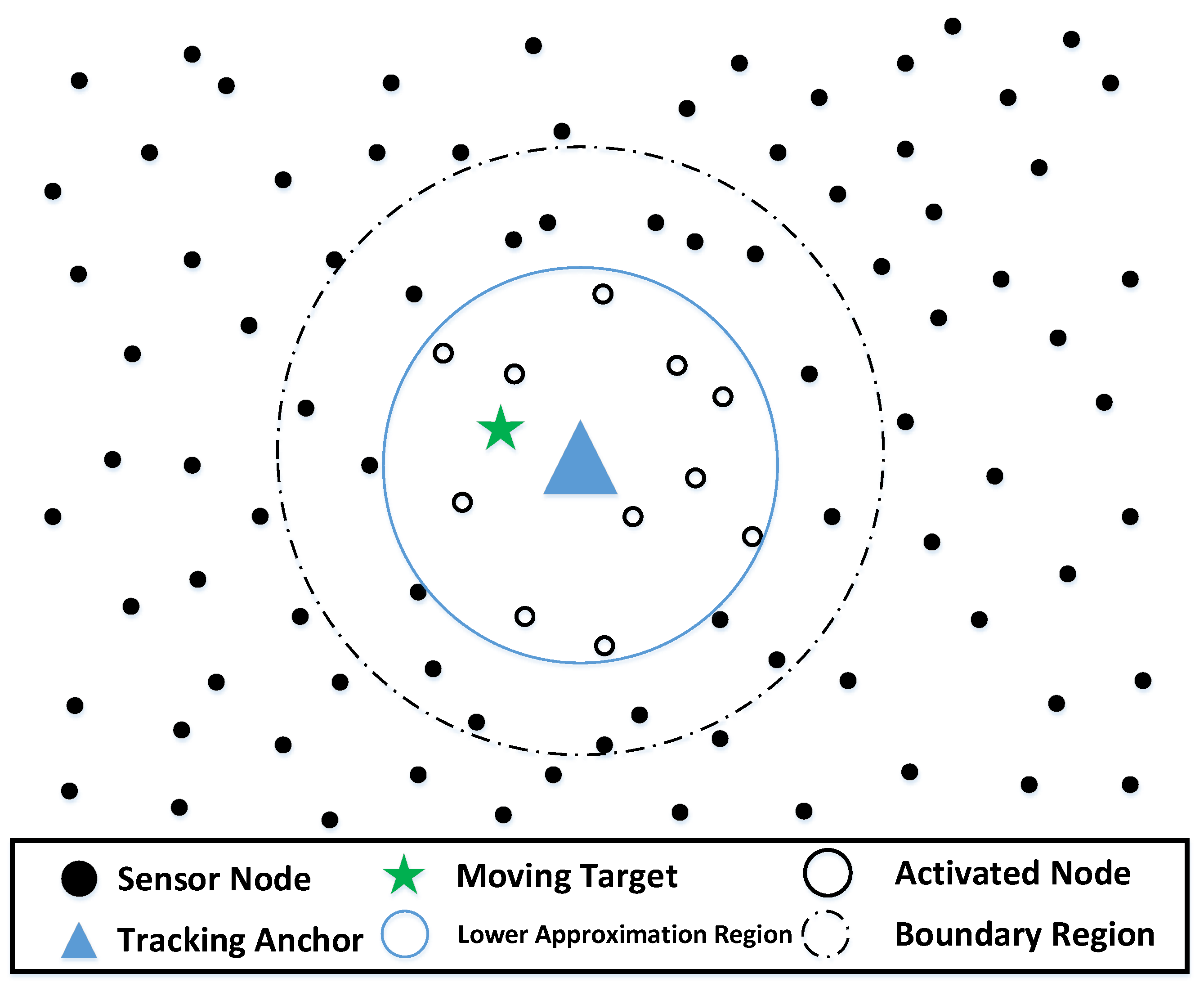
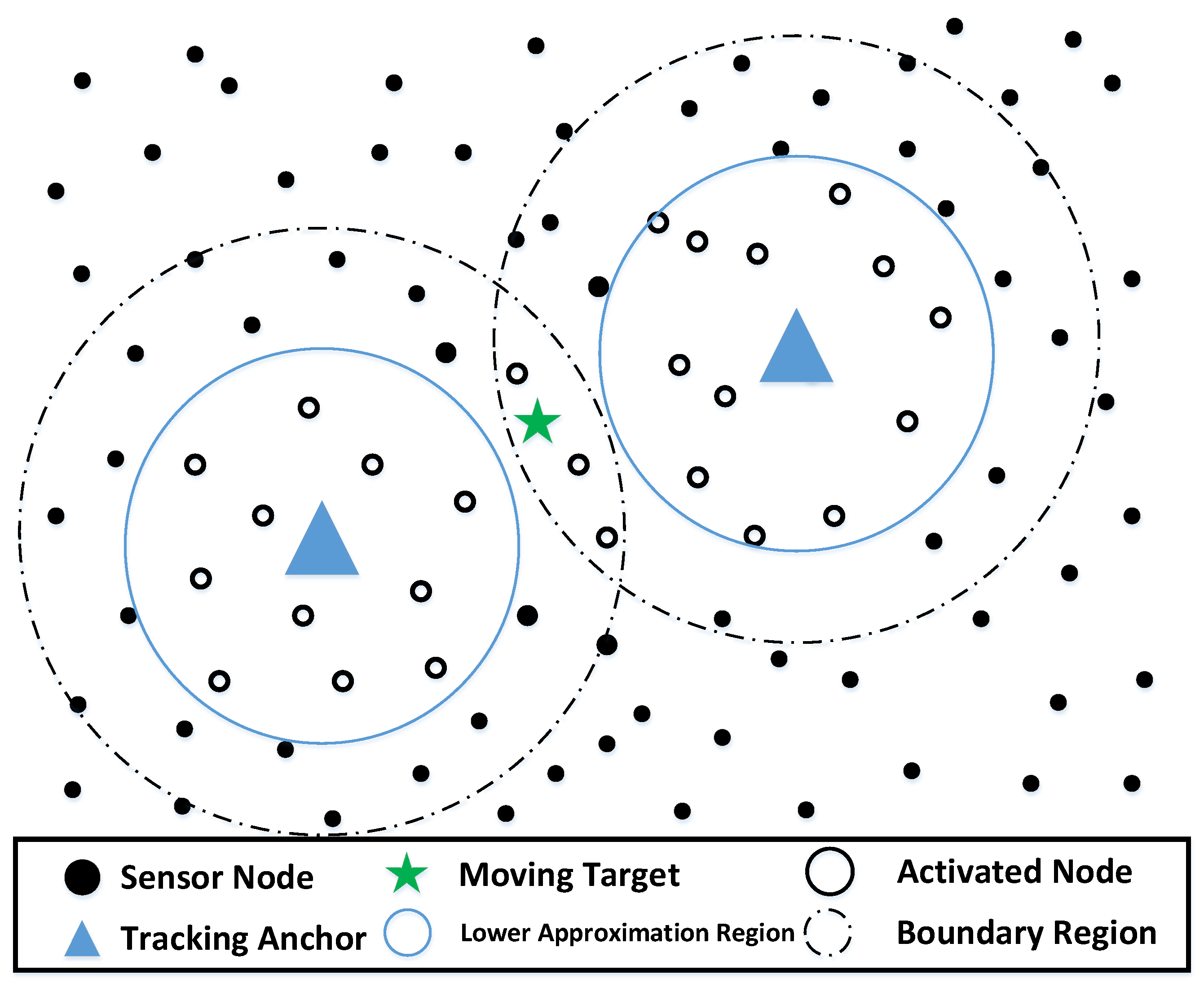

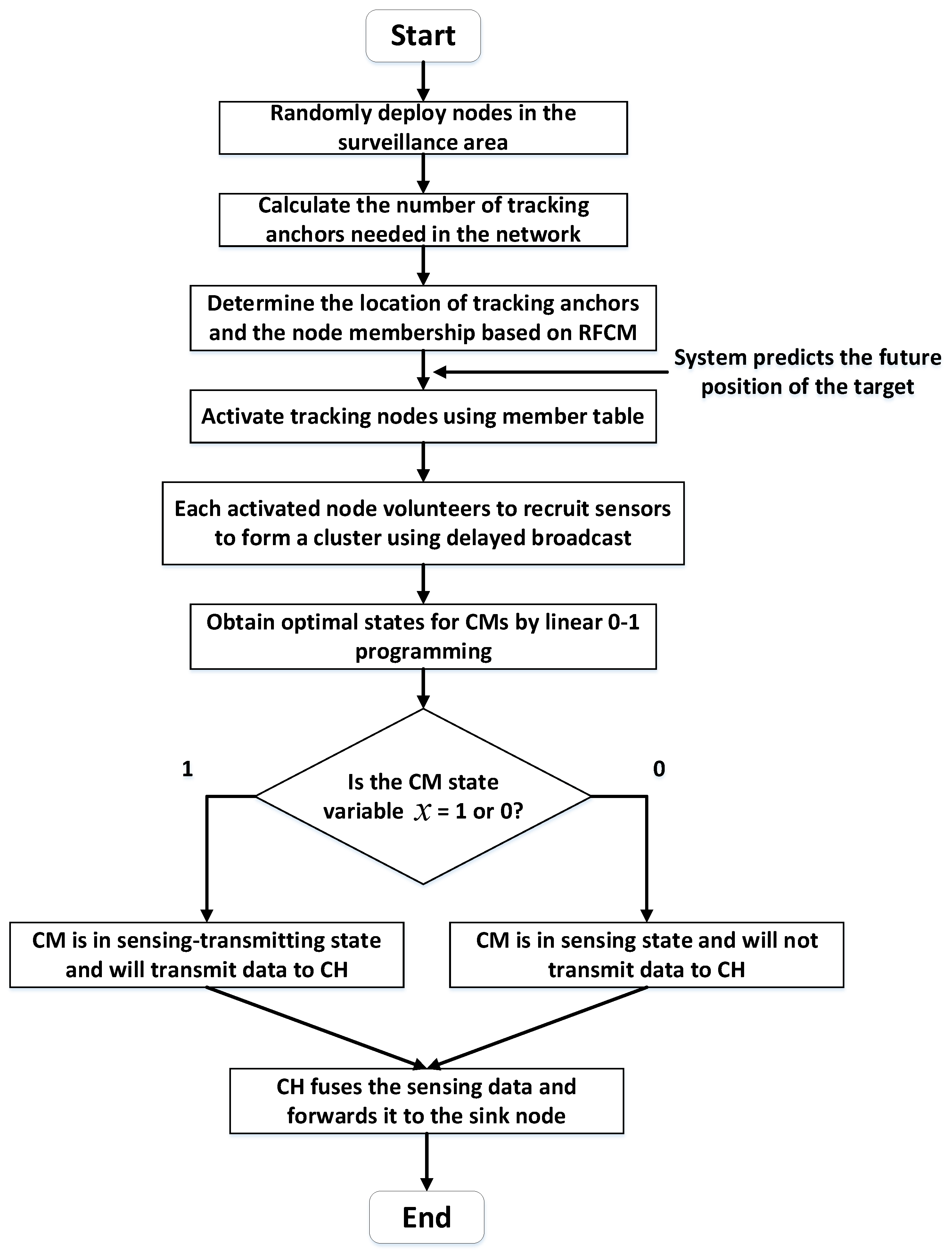

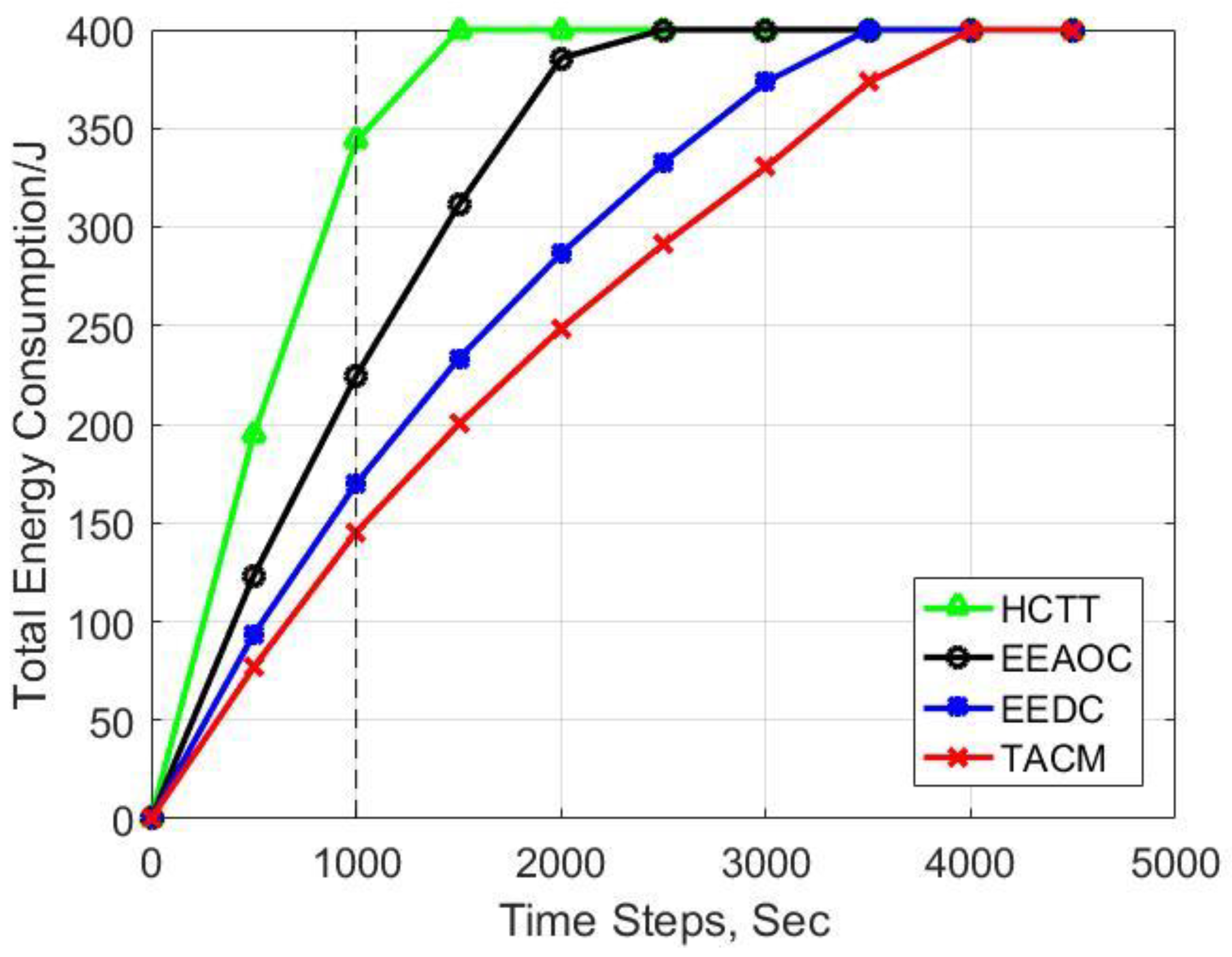

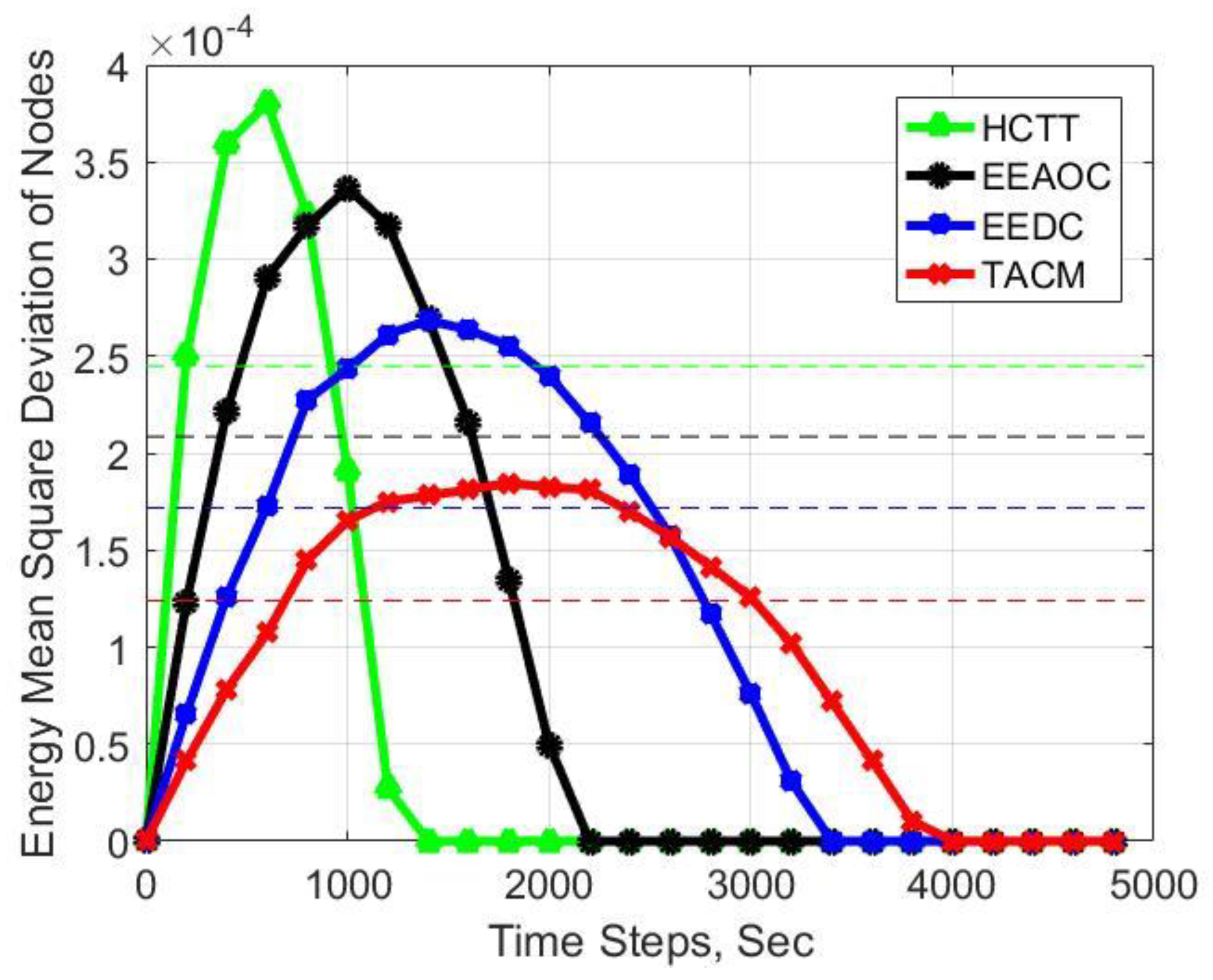

| Parameters | Value |
|---|---|
| Network Scale () | 500 500 |
| Node Number | 200–500 |
| Sink Coordinates () | (250, 250) |
| Initial Energy () | 1 |
| ) | 50 |
| ) | 10 |
| ) | 0.0013 |
| Data Packet Size (bit) | 4000 |
| Transmission Round (s) | 0.5 |
| Sensing Radius () | 20 |
| Communication Radius () | 40 |
| Maximum Iteration | 300 |
| Change Rate Threshold | 0.01 |
| Clustering Methods | Average Number of Activated Nodes |
|---|---|
| HCTT | 21.3 |
| EEAOC | 15.6 |
| EEDC | 12.3 |
| TACM | 10.5 |
Publisher’s Note: MDPI stays neutral with regard to jurisdictional claims in published maps and institutional affiliations. |
© 2022 by the authors. Licensee MDPI, Basel, Switzerland. This article is an open access article distributed under the terms and conditions of the Creative Commons Attribution (CC BY) license (https://creativecommons.org/licenses/by/4.0/).
Share and Cite
Qu, Z.; Li, B. An Energy-Efficient Clustering Method for Target Tracking Based on Tracking Anchors in Wireless Sensor Networks. Sensors 2022, 22, 5675. https://doi.org/10.3390/s22155675
Qu Z, Li B. An Energy-Efficient Clustering Method for Target Tracking Based on Tracking Anchors in Wireless Sensor Networks. Sensors. 2022; 22(15):5675. https://doi.org/10.3390/s22155675
Chicago/Turabian StyleQu, Zhiyi, and Baoqing Li. 2022. "An Energy-Efficient Clustering Method for Target Tracking Based on Tracking Anchors in Wireless Sensor Networks" Sensors 22, no. 15: 5675. https://doi.org/10.3390/s22155675
APA StyleQu, Z., & Li, B. (2022). An Energy-Efficient Clustering Method for Target Tracking Based on Tracking Anchors in Wireless Sensor Networks. Sensors, 22(15), 5675. https://doi.org/10.3390/s22155675







